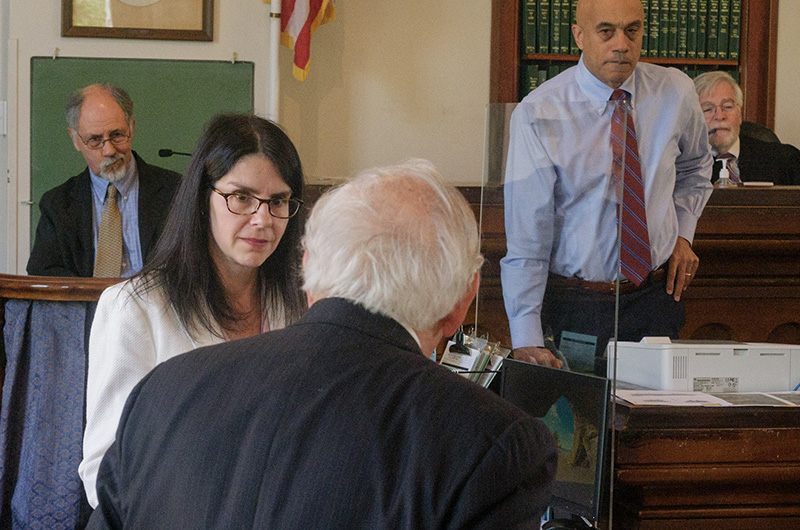Two conflicting views on the broad powers of the Martha’s Vineyard Commission to regulate development were aired in the weeklong civil trial which wrapped up on Tuesday in Dukes County superior court.
The case is an appeal of a vote by the MVC in 2020 to deny a large subdivision on the outskirts of Edgartown called Meeting House Place. The final version of the plan called for 28 market rate homes and 14 townhouses to be built on the 54-acre property.
“It’s nondescript land surrounded by 400 houses . . . this is where housing ought to go on Martha’s Vineyard,” said Edward T. Dangel, the attorney representing the developers during his opening statement at the outset of the trial last week. “They met all the environmental policies of the Martha’s Vineyard Commission, in fact they crushed them.”

But Johanna Schneider, attorney for the MVC, said the commission was doing its job when it denied the project. Created in 1974 by a special act of the legislature, the commission is charged with protect the Island’s unique environment from overdevelopment. That broad — and consequential — job requires wide authority in determining whether projects are suitable for the Island, Ms. Schneider said. Broad interpretive power also means sometimes going beyond written guidelines.
“The commission’s very reason for being is that the legislature determined that market demand for development did not adequately protect the unique built and natural environment of the Island,” she said during her opening statement.
The Hon. Paul D. Wilson, an associate justice of the superior court, presided over the bench trial, which ran for seven days.
The definition of Island character was a theme throughout the trial, as witnesses for both sides scrutinized various details of the plan, including density, open space and the affordable housing component.
The developers are a group called Meeting House Place LLC, based in Utah and Boston. They paid $6.6 million for the undeveloped land in 2017.
MVC review of the project as a development of regional impact (DRI) took place over nearly two years, with the developers presenting numerous revisions along the way. The revisions were a theme in the trial.
Mr. Dangel spent five days calling 14 witnesses. Testimony ranged from environmental experts to people who worked on the project to commission executive director Adam Turner. Plaintiffs’ attorneys focused on open space, wastewater mitigation, renewable energy and affordable housing to bolster their position that that the benefits of the project outweighed the detriments.
“We requested time to continue to go back to address commissioner concerns,” said Doug Hoehn, an Island civil engineer who worked on the project. “We were trying to add as many benefits to the project as we could.”
Three of the developers — David Blatt, Edward Champy and Doug Anderson — were present throughout the trial and all took the stand. Each testified to a different part of the plan, but their conclusions were the same: at some point in the review process they felt the project was bound to fail. Resolving one problem meant creating another for the commission, they said.
“It just became apparent to me we were stuck in an infinite loop and it would never get approved,” Mr. Anderson said. “We just had more and more items accumulate it seemed.”
The commission denied the project in part because it found it out of character with the surrounding area. Island architect Patrick Ahearn took issue with that characterization in witness testimony for the plaintiff, saying there is no such thing as a single Island character.
“This concept that there’s an Island character is a misnomer,” Mr. Ahearn said. “I believe with the design criteria . . . and numerous changes [to the plan] . . . if houses were to be built on that site, they could be characteristic of a variety of designs that would be Island appropriate.”
By contrast John Abrams, a West Tisbury builder and designer who was a witness for the commission, said the project was too dense and out of scale.
“We’ve never seen anything like it before . . . the development area of each parcel is very large and that will preclude much buffering,” Mr. Abrams said. “What it really has is development potential,” he also said.
Craig Richardson, a North Carolina
land-use expert and witness for the commission, agreed with Mr. Abrams. The market rate homes in the project would be twice the average size of homes in the area, he said. The size of the homes as well as the potential loss of native vegetation led Mr. Richardson to conclude the Meeting House proposal did not fit the character of the surrounding area.
“I just think the scale is too great,” Mr. Richardson said.
Mr. Dangel, an attorney based in Edgartown and Boston, was joined in the case by his co-counsel Kathleen Heyer, an associate at the Boston law firm Pierce Atwood. Ms. Schneider’s co-counsel was Pat Moore; both are partners at Hemenway & Barnes in Boston.
Briefs and transcripts will be prepared over the summer, and a decision in the case is not expected until later in the year.
Throughout the trial, Judge Wilson, who has extensive experience in land-use law, indicated his keen interest in the issues in the case.
“I went through three pens taking notes,” the judge told attorneys Tuesday after witness testimony had concluded and both sides were discussing the next steps in the process.
“This has been a very well tried case,” Judge Wilson said. “It’s been a pleasure being in front of the four of you.”





Comments
Comment policy »